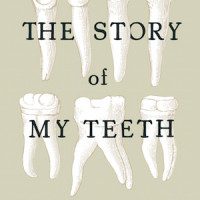In most popular histories, the artist Marcel Duchamp invented the readymade—a prefabricated or everyday object that is elevated by its context into art. The readymade carried heavy implications for the art world and continues to influence the idea of art as being intellectual or conceptual, rather than visual and technical.
The readymade is old hat—or close to it—in the art world. But Duchamp’s radical influence has been slower to catch on in American literature, even if there are authors from all over the world who have been influenced by the notion of the readymade—W.G. Sebald, Sheila Heti, Ben Lerner and Enrique Vila-Matas among them. It probably isn’t a coincidence that books that adopt the strategies of conceptual art frequently involve narrators with an interest in art.
Valeria Luiselli’s sophomore novel The Story of My Teeth subverts the idea of ready-mades as it takes on philosophical questions about art and value. The primary concept in what she has called a “novel-essay” is determining the inverse of ready-mades—how the value of art is changed once again, when it is removed from a museum or gallery or rich person’s house, and placed out in the world as an everyday object.
The Story of My Teeth is organized into seven brief “books,” most of them told from the perspective of Gustavo Sánchez Sánchez, known as “Highway.” He describes himself as the best auctioneer in the world, “very discreet.” He was born ugly, with four teeth. He worked for two decades in the Jumex factory before becoming an auctioneer. He is an extremely endearing character.
Early on, Highway notes that as an auctioneer he “wasn’t just a lowly seller of objects but, first and foremost, a lover and collector of good stories, which is the only honest way of modifying the value of an object.” This sentiment about storytelling foreshadows what’s to come.
At an auction, Highway bids on and procures Marilyn Monroe’s teeth. He amasses a collection of stories and other objects, including the teeth of various infamous people and ne’er-do-wells. What follows is a funny, loopy, and surreal account of an auction involving the sale of these teeth. Highway auctions them off with stories about their owners, named Plato, Augustine, Petrarch, Montaigne, Borges and so forth. The stories he tells bear no resemblance to what we actually know about these figures. Moreover, some of Highway’s family members are also named after famous figures.

What does it do to these literary names, to remove them from the comfort and familiarity of their own stories—to decontextualize them—and place them in stories that are not their own? These and other wonderful, wacky philosophical puzzles form the backbone of The Story of My Teeth. In addition to drawing from the art theory, the novel has a home within the Latin American tradition alongside authors like Enrique Vila-Matas who write highly allusive and playful metafiction. Vila-Matas even makes an appearance in the novel as the owner of a molar.
In some ways, the backstory for The Story of My Teeth is as interesting as the book itself. Luiselli was asked to write something on commission for an art gallery catalogue. The Grupo Jumex juice factory funds the art gallery. Luiselli wrote her book in installments (which I assume are the “books”). In the tradition of tobacco readers in Cuba, who read aloud to workers as they manufactured cigars, Luiselli’s installments were read and discussed by the factory workers. The conversations were taped, and she listened to them in mp3 form, allowing the conversations to inform her writing of the next installment. Another layer of collaboration was added when the translator created a timeline at the end of the book detailing where in history Highway’s exploits fell.
Although the book explicitly handles philosophical ideas, it is a far more straightforward narrative than Luiselli’s acclaimed debut novel about disappearing, Faces in the Crowd. Like Faces in the Crowd, the writing in The Story of My Teeth is elegant and the thinking sharp. But the voice of The Story of My Teeth is more compelling— earthy and grounded. It has plenty of connective tissue, so readers can enjoy decoding its allusions and symbols.
The interesting story of its production and the strong sensation that Highway’s story is encoded push The Story of My Teeth into the realm of the cerebral. While the novel does takes very weird turns, as a whole, particularly in terms of language, it doesn’t quite achieve the strange and uncanny pleasures of its ancestors—books by Vila-Matas, Borges, or Aira. How much of this is a matter of translation, I’m not sure. The reader’s conscious fun in untangling what is being said, in such a lovely, spare and playful voice, takes precedence over a more subconscious emotional rush. All told, The Story of My Teeth is guided by an exceptional, memorable intelligence.




